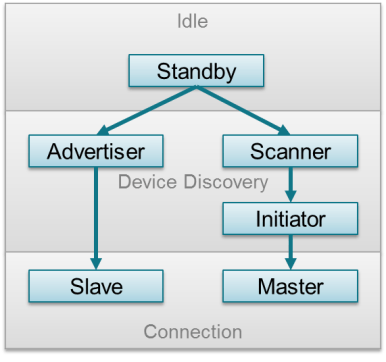SWRU271I October 2010 – January 2020 CC2540 , CC2540T , CC2541 , CC2541-Q1 , CC2640R2F
- Preface
- 1Overview
- 2The TI Bluetooth Low Energy Software Development Platform
- 3The Operating System Abstraction Layer (OSAL)
- 4The Application and Profiles
-
5The Bluetooth Low Energy Protocol Stack
- 5.1 Overview
- 5.2 Generic Access Profile (GAP)
- 5.3 GAPRole Task
- 5.4 Gap Bond Manager (GAPBondMgr)
- 5.5
Generic Attribute Profile (GATT)
- 5.5.1 GATT Characteristics and Attributes
- 5.5.2 GATT Services and Profile
- 5.5.3 GATT Client Abstraction
- 5.5.4 GATT Server Abstraction
- 5.6 L2CAP
- 5.7 HCI
- 5.8 Library Files
- 6Drivers
- 7Creating a Custom Bluetooth Low Energy Application
- 8Development and Debugging
-
9General Information
- 9.1 Overview
- 9.2 Porting From BLE-Stack 1.5.0 to 1.5.1
- 9.3 Porting From BLE-Stack 1.4.2 to 1.5.0
- 9.4
Porting From Earlier BLE-Stack Versions
- 9.4.1 Porting BLEv1.4.1 Projects to BLEv1.4.2
- 9.4.2 Porting BLEv1.4.0 Projects to BLEv1.4.1
- 9.4.3 Porting BLEv1.3.2 Projects to BLEv1.4.0
- 9.4.4 Porting BLEv1.2 Projects to BLEv1.3
- 9.4.5 Porting From CC2540 to CC2541 Project
- 9.5 Release Notes History
- 9.6 Document History
- A GAP API
- B GAPRole Peripheral Role API
- C GAPRole Central Role API
- D GATT/ATT API
- E GATTServApp API
- F GAPBondMgr API
- G HCI Extension API
- Revision History
5.2.1 Overview
The GAP layer of the Bluetooth Low Energy protocol stack defines the behavior of devices performing the following actions:
- Device discovery
- Link establishment
- Link termination
- Initiation of security features
- Device configuration
For an overview of possible device states, see Figure 5-1.
 Figure 5-1 GAP State Diagram
Figure 5-1 GAP State Diagram The following describes the possible device states:
- Standby: the initial idle state following reset or when the Bluetooth Low Energy stack is not active
- Advertiser: The device advertises with specific data that signals it can connect to any initiating devices. This advertisement contains the device address and additional data such as the device name.
- Scanner: When receiving the advertisement, the scanning device sends a request to scan the advertiser. The advertiser responds with a scan response. This process outlines how the device discovers other devices. The scanning device reads the advertising device and determines whether or not they can connect.
- Initiator: When initiating, the initiator must specify a peer device address with which to connect. If the initiator receives an advertisement that matches the address of the peer device, the initiator will request to establish a connection with the advertising device. The initiator specifies the initial connection parameters when the connection is formed.
- Master or Slave: If the device was the advertiser , it becomes a slave after connecting. If the device was the initiator, it becomes a master after connecting.